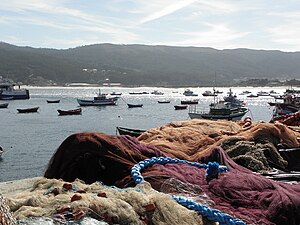|
Costa da Morte Costa da Morte (Galician: [ˈkɔstɐ ðɐ ˈmɔɾtɪ]; "Coast of Death") is a part of the Galician coast. The most common definition of the Costa da Morte states that it extends from Cape Finisterre to Malpica, although some may debate it extends from Muros to A Coruña.[1] BackgroundThe Costa da Morte received its name because there have been so many shipwrecks along its treacherous rocky shore. The shore of the Costa da Morte is exposed directly to the Atlantic Ocean. It is an area that has suffered a number of oil spills, including the spill from the Prestige in 2002. The exterior cape region is known for anthropological, historical and geographical reasons. Its name in the Galician language is Fisterra, which descends from the Roman legend which held that this area was the end of the world (Finis-terrae). The area was largely Christianized by the Catholic Church with the aid of a large flux of Christian pilgrims arriving on the Way of St. James. The people of the area still preserve pre-Christian ritual places and pass on some of the traditional beliefs. For example, there are giant pedras de abalar (i.e. "oscillating stones", the common term in English is rocking stone) throughout the region. These pedras de abalar were sacred locations and used in various rituals that are remembered in local culture. There is also a local legend that the wind creates wild nightmares. Major commercial and fishing portsGeographyThe Costa da Morte includes Cape Finisterre (Galician: Cabo Fisterra), a rock-bound peninsula in the uttermost west of Galicia, Spain. Contrary to popular assumption, Cape Finisterre is not the westernmost point of Spain. Instead, the westernmost landmark in Galicia and Spain is Cabo Touriñán, which is found just to the north of Fisterra. Fisterra's name, like that of Finistère in Brittany (France), is derived from the Latin word Finisterrae; translating to "Land's End". This name was coined several centuries ago, when the Romans thought Cape Finisterre was the end of the Earth, as the American continent was unknown to the Western world at the time.[2] Cape Finisterre has a notable lighthouse on it, and the seaside town of Fisterra is located nearby. Nevertheless, Cape Finisterre is not the only cape that Costa da Morte includes; one can also see Cabo Touriñán as well as Cape Vilán.[3] The Rías Altas are located to the north.[4] Locations These are some of the towns, villages, hamlets and cities along the Costa da Morte:
See alsoReferences
|